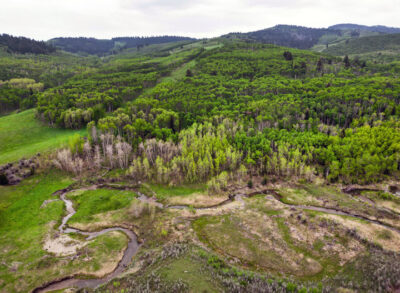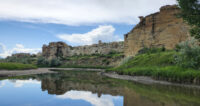NCC expanding efforts in Porcupine Hills
By Alejandra Pulido-Guzman - Lethbridge Herald on November 18, 2023.
 Waterways, woodlands and rock formations are part of the landscape that the Nature Conservancy of Canada looks to preserve in the southern foothills. NCC photo by Sean Feagan
Waterways, woodlands and rock formations are part of the landscape that the Nature Conservancy of Canada looks to preserve in the southern foothills. NCC photo by Sean FeaganLETHBRIDGE HERALDapulido@lethbridgeherald.com
The Nature Conservancy of Canada has announced an expansion to their conservation efforts in the Porcupine Hill area, the equivalent to 4,000 Canadian Football League football fields in size.
Spanning over 2,500 hectares, three grassland properties are now conserved in partnership with local landowners through a conservation agreement with NCC, which builds upon the conservancy’s longstanding efforts to create a network of conserved lands in the Porcupine Hills.
NCC media and communications coordinator Sean Feagan said each of those three properties have been conserved through an agreement between NCC and an anonymous landowner.
“Conservation agreements are one of the main ways NCC works to conserve land in Alberta. It’s a mechanism that’s entrenched in provincial law, and basically each agreement will prevent the conversion of natural habitats, land cover, of these properties to any other purpose,” said Feagan.
He said with those agreements in place, landowners will not be able to make changes to the land such as clearing the grasslands to plant crops, subdividing the property into smaller parcels and sell it to a developer or draining any wetland.
“Basically these agreements will maintain the natural values of the land for the benefits of species and the people, while also ensuring each property will continue to operate as a working landscape for cattle grazing,” said Feagan.
He said the restrictions placed on the land by the conservation agreements are in perpetuity and will prevail long after owners either sell their property or die.
Feagan said that due to the restrictions placed on their land, owners are compensated for their developing rights with anywhere between 25 to 30 per cent of the land value.
The Government of Alberta created the Alberta Land Trust Grant program in 2011 – a program designed to support land trusts such as the Nature Conservancy of Canada, to assist in the purchase of conservation agreements on ecologically significant landscapes and donations of land with high conservation value.
“Two of the three projects were supported by the Alberta Land Trust Grant. In all three cases, the landowner donated a portion of the conservation agreement value to NCC,” said Feagan.
He said these newly conserved lands serve as important movement corridors for wildlife, and by conserving these corridors, NCC is helping to maintain healthy ecosystems and diverse wildlife populations.
“Grasslands are one of the most threatened ecosystems on the planet, and they are right here in our own backyard. Only about 18 per cent of grasslands remain in Canada, so anytime you can conserve grassland areas, you’re helping threatened grassland species,” said Feagan.
 He said some of the threatened grassland species include a bird called Sprague’s pipit, a plant called limber pine, and animals including grizzly bears and American badgers.
“When we think about grizzly bears, we think of them as mountain species, but they are found on grasslands too, and this (Porcupine Hills) is one of the few areas where we can still see Grizzly bears on grasslands,” said Feagan.
Follow @APulidoHerald on Twitter
17-16




